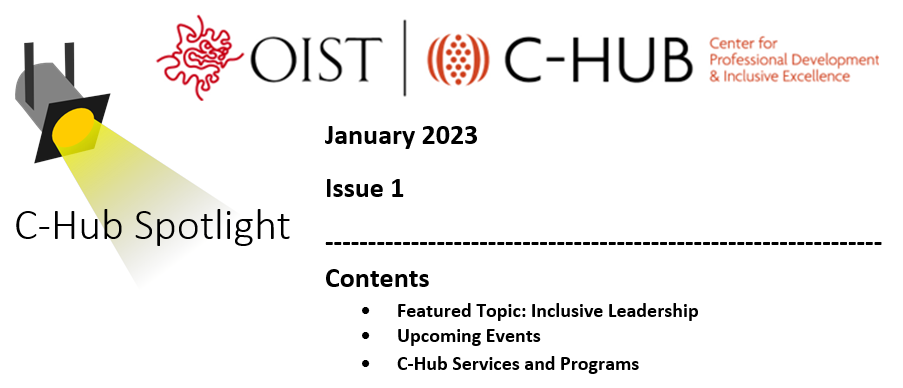C-Hub Spotlight Issue 1, January 2023

Featured Topic: Inclusive Leadership
The aim of inclusive leadership is to develop institutional cultures that are human-centered, where the capabilities and contributions of each individual are recognized and valued in an environment that deliberately fosters safety and trust. Inclusive leadership is characterized by action rather than hierarchical position. It engenders conditions or climates that enhance adaptability, collaboration, and a strong sense of community and belonging to deliver meaningful results and lasting change. Diversity is an institutional asset - inclusive leadership empowers diversity by enabling individuals and teams to enact their full potential by respecting uniqueness at the individual level. This critical stance contrasts greatly from self-serving leadership that focuses on differentiation, assimilation, or outright exclusion. Impactful leaders can be anyone in the organization rather than those in official leadership positions. To learn more about how you can cultivate community and sense of belonging at OIST, attend C-Hub’s Inclusive Leadership Symposium, February 1 & 2, with talks, panels, and posters from a diverse assembly of inclusive leadership practitioners.
What’s the evidence?

Korkmaz et al., 2022
The four core behaviors (Fostering uniqueness; Strengthening belongingness; Showing appreciation; Supporting organizational efforts) are further enhanced by leadership that promotes exhibiting visibility, accessibility, and availability in interactions, together with shared decision-making opportunities and the encouragement of diverse contributions. Universities and organizations benefit from the collective nature of inclusive leadership, which enhances strong work-group identification from increased psychological safety and empowerment of group members. Individuals can unleash their full potential toward creative and innovative collaboration with others across boundaries, resulting in increased capabilities to respond to challenges and develop resilience.
What can YOU do?
Regardless of your position in the organization, you can have impact at various levels by modeling and mentoring inclusive leadership practices. Here are five ways to take steps toward inclusive leadership.
- Hold ourselves accountable for ensuring that those that have traditionally held positions of privilege or have benefitted from being part of a majority do not perpetuate the “norms” of a dominant culture.
- Create spaces to promote discourse and exchange, where colleagues are empowered to contribute their experiences, expertise, and perspectives.
- Work collaboratively to connect individual distinctiveness and group identities to a shared OIST identity, through values affirmation and by actively mitigating bias.
- Advocate for underrepresented voices and decrease the burden of responsibility for those that have been underrepresented/invisible.
- Consider what it means to engage in servant leadership – that is, to lead in service of the collective shared goals of a university or organization – and what actions you can take in your role.
Upcoming Events:
- Inclusive Leadership Symposium 2023, February 1 (10 am-5 pm) & February 2 (10 am- 4 pm), OIST Auditorium and Conference Center [public and OIST members]
References and Further Reading:
Ernst, C. & Yip, J. (2009) Boundary spanning leadership: Tactics for bridging social boundaries in organization. In T. Pittinsky (Ed.) Crossing the divide: Intergroup leadership in a world of difference. Boston, MA: Harvard Business School Press.
Korkmaz, A. V., van Engen, M. L., Knappert, L., & Schalk, R. (2022). About and beyond leading uniqueness and belongingness: A systematic review of inclusive leadership research. Human Resource Management Review, 32(4).
Kugelmass, J. W. (2003). Inclusive leadership: Leadership for inclusion. National College for School Leadership.



